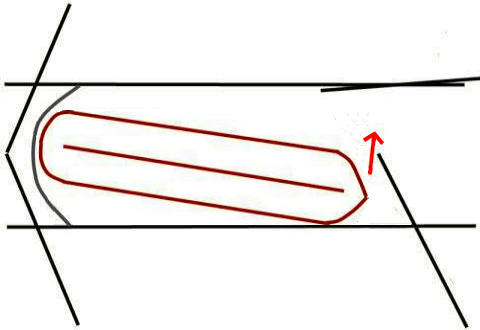The maximum boat dimensions for most of the locks on the Calder and Hebble Navigation above Broad Cut Lock are 57' 6" length and 14' beam. These dimensions also apply to the Huddersfield Broad Canal.
Narrowboats of up to 60' can just fit into the locks at an angle with great care.
Below is some guidance for taking a narrowboat over 57' 6" in length through the shorter Calder and Hebble locks, and locks on the Huddersfield Broad Canal. It is only guidance and you follow it at your own risk. If the guidance is followed carefully, the boat will remain safe. However, any boater following it must use their discretion and remain alert to the possible dangers at all times.
Because of the tightness of some locks for a narrowboat over 57' 6", the lock crew must remain vigilant and be prepared to drop paddles immediately should a problem occur.
(A handspike-operated paddle can usually be dropped quickly by flicking up the pawl with the handspike.)

Approximate position needed for boat over 57' 6" going uphill in order to close the bottom gate.
When going uphill in a narrowboat over 57' 6":
- open one bottom gate
- move the boat in through that gate
- move the stern of the boat across behind the closed gate
- shut the bottom gate that was open
- fill lock as usual, opening ground paddles first
- take care that the stern is not too close to bottom gates - there is a walkway sticking out that could foul the tiller and snap it off!
- open gate paddles with care, to avoid flooding the well deck of the boat, as this will be near the top gates
In some locks, it may be possible to fit a shorter boat in alongside, but not for two narrowboats over 57' 6" to share, as it will not be possible to close the bottom gates.

Approximate position needed for boat over 57' 6" going downhill in order to open the bottom gate.
When going downhill in a narrowboat over 57' 6":
- open one or both top gates
- move boat into lock
- close the top gates
- position the bow of the boat so that it is in a corner behind one or other of the bottom gates
- move the stern of the boat to the middle, as the cills are curved and there is more length available in the middle
- turn the tiller fully to one side to reduce the risk of the rudder touching the cill
- empty the lock as usual (or with caution if the lock is particularly short)
- keep an eye on the cill markings at the side of the lock - in some locks the rudder will be fairly close to the cill! (make sure the lock operator is alert and ready to drop the paddles quickly if there is a problem)
- when lock is empty, open one bottom gate on the side opposite to the bow of the boat
- using pole or thruster, move bow of boat across
- exit lock through open gate
In some locks, it may be possible to fit a shorter boat in alongside (but take care that the stern does not go beyond the cill markings), but not for two narrowboats over 57' 6" to share, as it will not be possible to open the bottom gates.
The exact lengths of the locks is quite variable from one to another. The two upper Salterhebble Locks are the shortest on the whole canal. It is occasionally necessary for a boat to go down these locks backwards. It is possible to wind above and below these two locks.
It must be pointed out that passing through some of these locks, especially the two upper Salterhebble Locks, with a narrowboat of 60' length is tricky and a very tight fit, with the risk of the rudder catching the cill on descent. With a boat a fraction over 60', the bottom gates will not open/close. Anyone planning to buy a boat and intending to use these canals regularly would be recommended to go for a length not exceeding 59'.